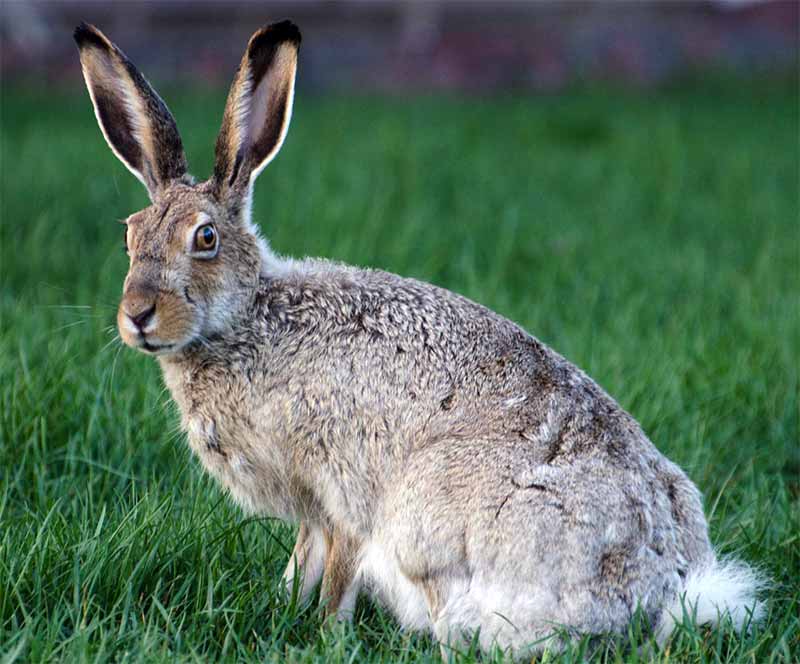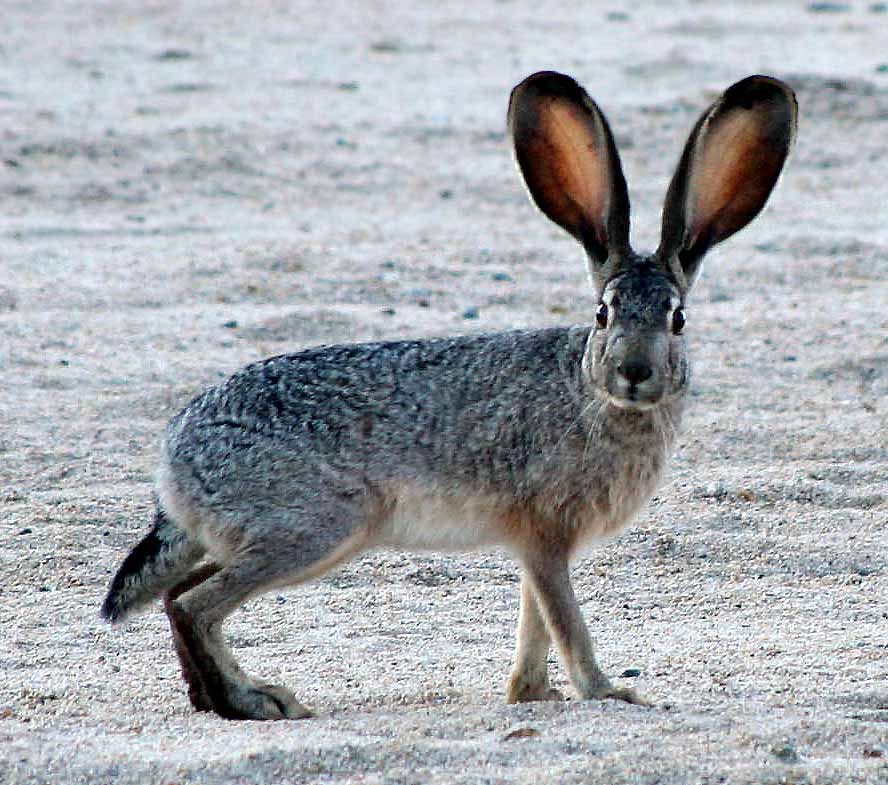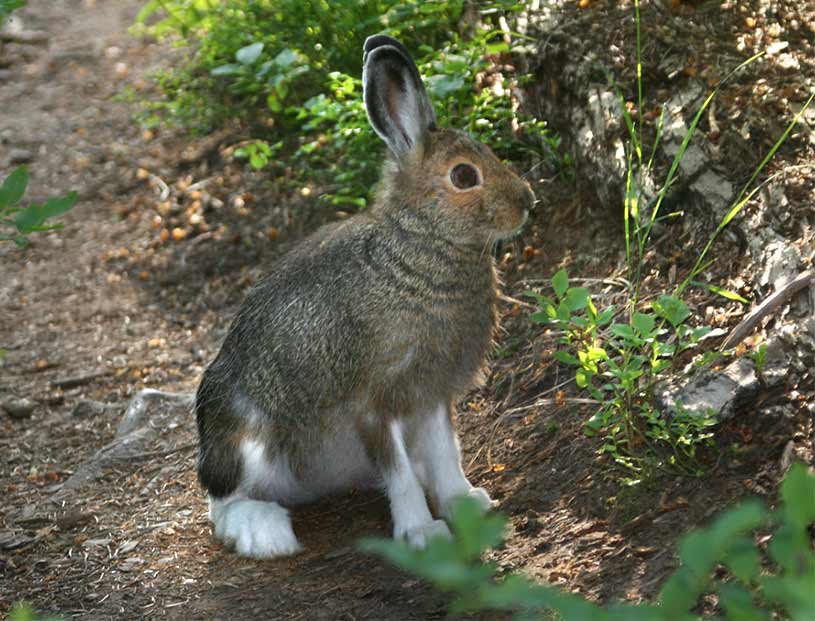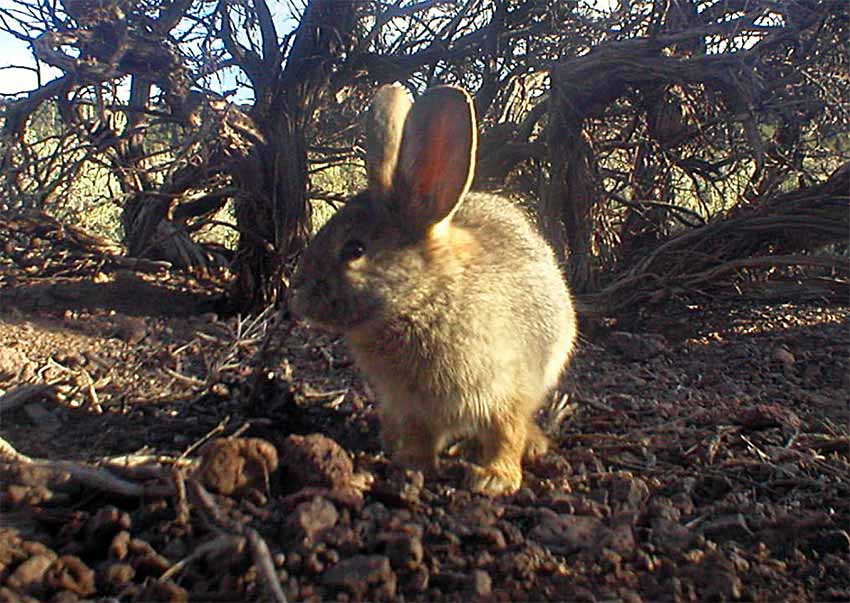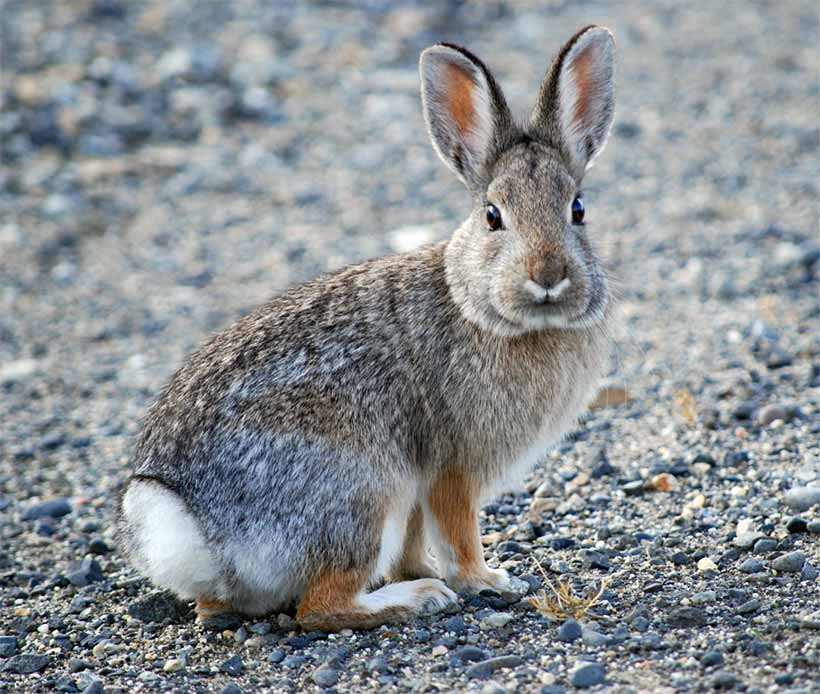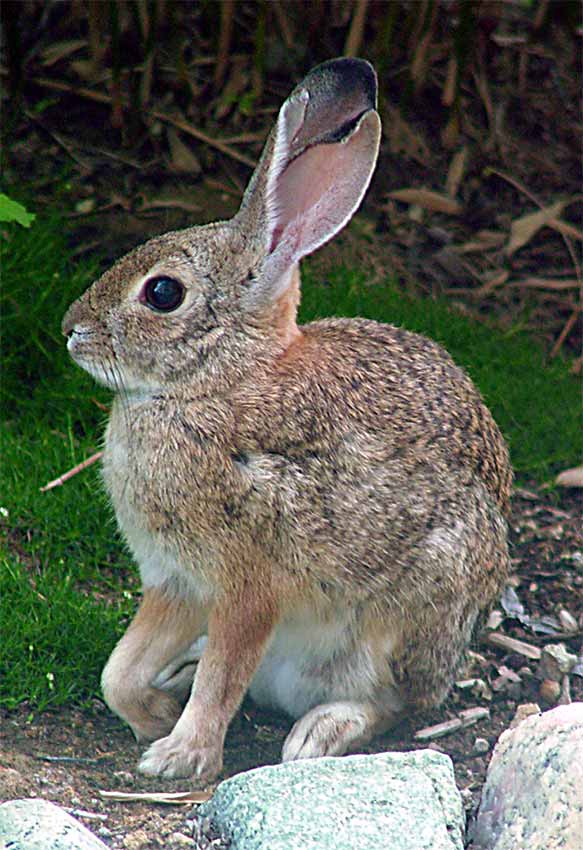Biology and ecology of Utah rabbits and hares
Dean L. Mitchell
Former DWR Upland Game Program Coordinator
Paul Klimack
Research Assistant, USU Extension Services
The Utah Division of Wildlife Resources takes numerous telephone calls from concerned hunters about diseases, and more commonly, parasites found on rabbits and hares. Hunters who call are distressed about the edibility of their game. They are also concerned about the transmission of disease from game they've harvested to humans.
Biology and ecology of rabbits and hares
In Utah there are three species of hares and three species of rabbits. The hares consist of the white-tailed jackrabbit (Lepus townsendii), the black-tailed jackrabbit (Lepus californicus) and the snowshoe hare (Lepus americanus). The pygmy rabbit (Sylvilagus idahoensis), the mountain cottontail (Sylvilagus nuttalli) and the desert cottontail (Sylvilagus audubonii) make up the rabbit group.
There are fundamental differences between rabbits and hares. Hares live above ground in a small leaf-litter depression, which is often on a hill or other slight elevation. The elevated depression allows the hare to keep a watchful eye out for predators and other animals. Rabbits tend to live in burrows underground. Burrows are 6–7 inches long, 3–5 inches deep and five inches wide. Occasionally, rabbits will move into the abandoned den of some other animal.
Another difference is that hares are precocial and rabbits are altricial. Precocial means the offspring of hares, at birth, are open-eyed and furred and thus are capable of a high degree of independent activity from birth.
Rabbits, on the other hand, produce closed-eye and naked or altricial young. Altricial means that offspring are helpless at birth and require parental care for sometime afterward.
In Utah, the pygmy rabbit, mountain cottontail, desert cottontail and snowshoe hare are protected. All but the pygmy rabbit can be hunted during specific seasons. The white and black-tailed jackrabbits are not protected and can be hunted any time with any weapon.
Rabbits
Cottontail rabbits are smaller than jackrabbits or hares in overall size. Their ears are shorter and the hind feet are noticeably smaller.
The pygmy rabbit is the smallest in Utah and can be distinguished from all other rabbits by it's small size. It is not a "true" cottontail. The main differences are the small size and white, buffy tail. It is 8–11 inches long, weighs only 1/2–1 pound and has an ear length of 2 inches. The color is slate gray with a pinkish tinge. It is found around tall, dense, rank clumps of sage brush. This rabbit occurs mainly in the western half of Utah. Although mainly nocturnal, the pygmy rabbit does occasionally appear throughout the day. Diet consists primarily of sagebrush.
The mountain cottontail has a length of 12–14 inches, has a weight of 1–3 pounds and ears 2–2 1/2 inches long. This rabbit is brownish gray both summer and winter. It is generally found above 6,000 feet and prefers to live in thickets, sagebrush, rockpiles and cliffs. It is a common rabbit and can be found throughout the state. It is most active from early evening to late morning. This cottontail feeds on grass in the summer and twigs in the winter.
The desert cottontail is 12–15 inches long, weighs 1–3 pounds, with ears 3–4 inches in length. The fur is a pale gray color with a yellowish tinge. It is a common rabbit in Utah and can be found below 6,000 feet on open plains, foothills, low valleys, around sagebrush, pinions and junipers. From late afternoon throughout the night is when the desert cottontail is most active. It mainly eats grasses and sagebrush.
Hares
The white-tailed jackrabbit is large and weighs from 5–10 pounds. The body length is 18–22 inches with ears about 5–6 inches in length. This hare is gray/brown in summer and turns all white in the winter except for the tips of the ears and top of the head which remains a grizzled gray or black. A distinguishing feature is the tail which is almost always white above and below. The white-tailed jackrabbit is found throughout Utah except for the southeastern corner and west deserts. It prefers to live in open, grassy or sagebrush plains. It is mostly nocturnal and sits in a lair during the day. In summer it eats primarily grasses and in the winter it feeds mainly on buds, bark and small twigs.
The black-tailed jackrabbit is smaller than the white-tailed jackrabbit with total weight ranging from 3–7 pounds and length from 17–24 inches. Ears are 6–7 inches in length. It can be identified by it's gray/brown body (summer and winter), large black-tipped ears and the tail, which has black streak along the top. It's belly and the underside of the tail are white. This hare prefers open prairie regions, foothills and sparsely vegetated deserts. It is found throughout Utah except for the extreme northeastern part of the state. Early evenings through early mornings is when the black-tailed jackrabbit is most active. Diet consists almost entirely of green vegetation.
The snowshoe hare is 13–18 inches long, 2–4 pounds in weight and has an ear length of 3–4 inches. This hare has large feet resembling a snowshoe. It is totally white in the winter and dark brown in the summer. In Utah, it is found mainly in coniferous forests and aspen, alder, and willow thickets of the higher mountain regions. It is nocturnal and sits in bushes or brushy cover during the day. In the summer it feeds on grasses and other green vegetation while in winter, it eats buds, bark and twigs.
Tularemia in rabbits and hares
Tularemia is a disease which occurs throughout the Northern Hemisphere and can be found in many mammals including hares, rabbits and rodents common in Utah! The disease is also called rabbit fever, fly fever and Ohara's disease. It has a particular affinity for cottontail rabbits. Tularemia is caused by the bacteria (Francisella tularensis). Tularemia can be transmitted to man either by the bite of an infected tick or deer fly, direct contact through the skin via dressing an infected animal, eating of contaminated flesh, or inhalation of dust that is carrying the bacteria.
After entering the rabbit's body, via the bite of an infected parasite, the bacteria quickly multiplies and invades different organs such as the liver and spleen. If while dressing your rabbits, you notice one in which the liver, lungs or spleen are covered with tiny, whitish miniature discolorations or one in which the liver and spleen are swollen, it is probable that the rabbit has tularemia. Immediately wash your hands with strong soap and hot water and rinse in disinfectant and discard the carcass.
Tularemia is a serious disease, if left unchecked. But don't panic! Based on statistics from around the United States, chances of catching Tularemia are slight.
Symptoms in rabbits and hares
Infected rabbits will not readily flush from cover. They will run slowly and can be captured easily. Infected rabbits generally cannot raise their heads and can't maneuver their front feet very well. You may see infected rabbits rubbing their noses and forefeet into the ground often. They may have irregular muscular spasms and, at times, stagger only a few feet between spasms.
Symptoms in humans
After infection has occurred, the bacteria incubate for approximately five days. The resulting symptoms appear suddenly and include chills, fever, nausea, vomiting and sweating. If you suspect that you have been in contact with an infected animal and may have contracted Tularemia, consult your physician immediately! The recovery rate from the disease is good.
Parasites
Hares and rabbits act as the host for a variety of ticks, lice and other external parasites. These external parasites do not harm the rabbit and tend to be active only during the warmer months of the year.
One form of external parasite that you may encounter on rabbits is known as the Warble-fly or Bot-fly (Cuterebra cuniculi). It is actually the larval "grub" of this fly that is quite unpleasant to look at. The warble-fly larvae burrow into the flesh and can be found in the neck, spine and groin region of the rabbit. The grub lives under the skin of cottontails until it develops into an adult fly. The grub is black in color and about one inch in length. It is one half to an inch wide, has a segmented appearance and is covered with short, black bristles. The larval grub does not lessen food quality of the meat except at the point of contact. Remove the small area of affected flesh that was around the grub and the rest of the meat will be perfectly edible!
Other parasites can be found on the skin and fur of rabbits and hares. These include ticks, mites, lice and ked-flies.
Ticks are common and may be found in high numbers. This parasite looks like a flax seed and is brownish in color. It feeds on blood and is usually found on the nose and ears—places that have the least fur. Initially being the size of a flax seed, the tick soon swells to the size of a grape as it becomes engorged with blood.
Mites are tiny parasites that infect many animals, including rabbits. So small that they go unnoticed. They are round, range in color from black to red and are found next to the skin or in the ears.
Lice are a blood-sucking, wingless parasite that is found on the skin and in the fur of rabbits. Lice are large enough to be seen with the naked eye. They have legs at the front of the body with a long, oval abdomen in the rear.
Field dressing rabbits and hares
Once you have your rabbit, it must be dressed properly and quickly to avoid spoilage. To skin, make a small incision into the skin on the belly. Work your fingers between the rabbit's skin and body cavity until they meet at the back. Next break the skin and pull it off in both directions. Cut off the head, feet and tail. Cut the animal open from breastbone to vent. Use rubber gloves and remove all organs. Be sure to bury all the entrails. Cut the animal into serving size pieces. The meat should be cooled, immediately, before placing into your game carrier. This can be accomplished by hanging the meat from your belt. Do not use water as this may cause the meat to spoil. When cooled sufficiently, the meat should be transported in plastic bags for cleanliness.
If you suspect you have shot an animal infected with Tularemia, do not handle it. Rather, bury it or cover the carcass with rocks to prevent scavengers from feeding on it.
When handling cottontail rabbits during the warmer months, wear a pair of gloves. Gloves will protect you from being bitten by external parasites that live on the rabbit and will minimize direct contact between the carcass and your skin. If no gloves are worn, thoroughly wipe your hands and other areas of contact with antiseptic wipes.
Wear clothing with tight wristbands and tuck pants into boots in tick-infested areas. In addition, game carriers can be used instead of putting rabbits into a game pocket or vest. This will lessen the chance of contact with external parasites.


